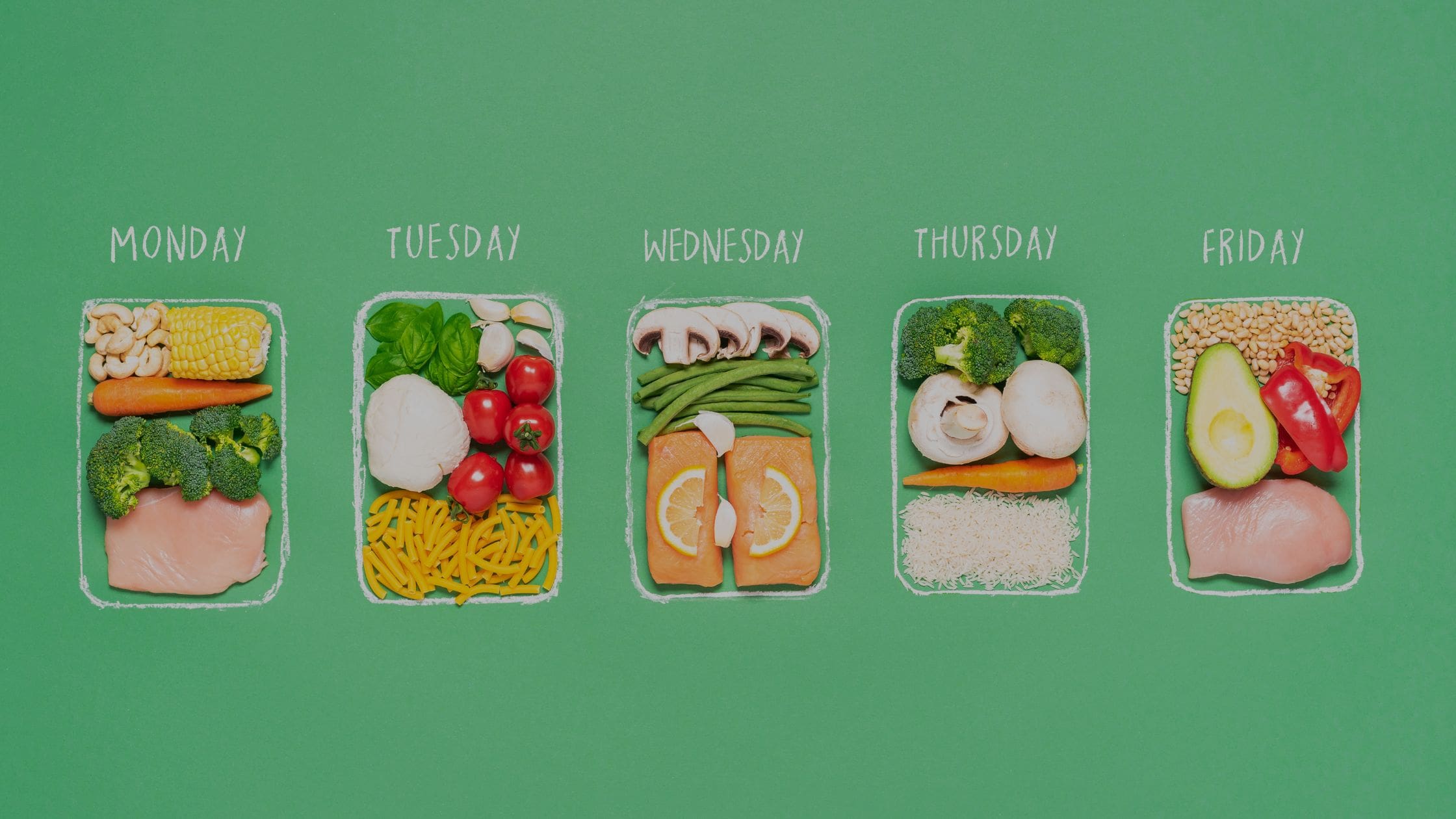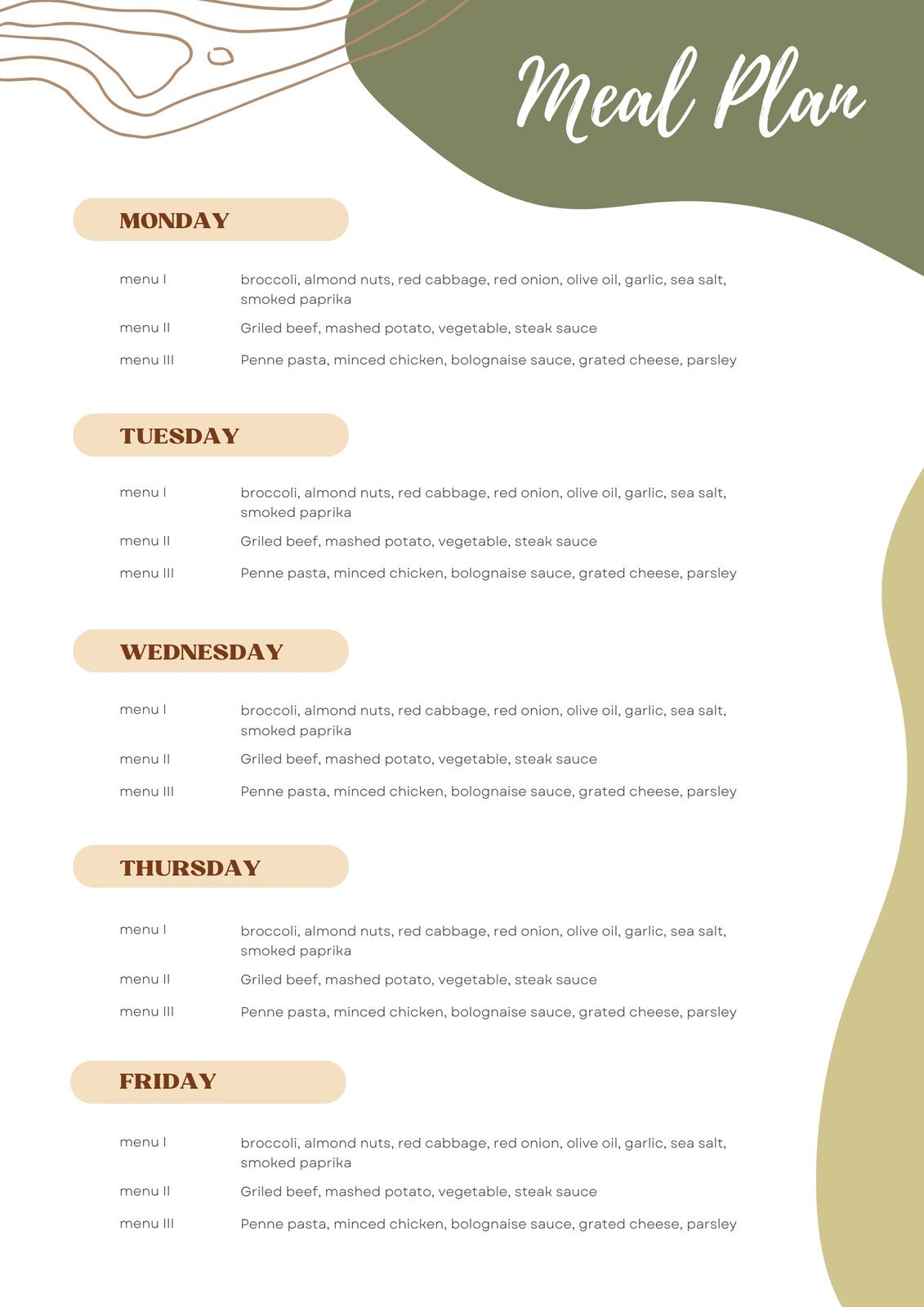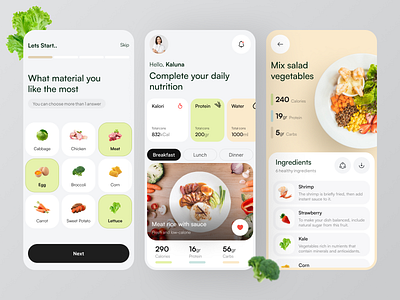
The surge in dietary consciousness is undeniable. A recent survey by the International Food Information Council reveals that 52% of Americans are following a diet or eating pattern in 2023, up from 39% in 2021. This trend reflects a growing awareness of the importance of nutrition in our overall health and well-being.
I remember standing in my kitchen, overwhelmed by the prospect of planning meals that aligned with my health goals. Fast forward to today, and I’m here to guide you through the intricacies of meal planning on a diet in 2024. This comprehensive guide will equip you with the knowledge and strategies to create a personalized, effective meal plan that supports your unique dietary needs and goals.
Before we dive into the specifics of meal planning, it’s crucial to understand that a successful personalized nutrition journey is key to achieving your health goals. This guide will help you create a meal plan that aligns with your unique needs and preferences.

Source: The Real Food Dietitians
Understanding Your Dietary Landscape
Before diving into meal planning, it’s crucial to understand your current dietary situation. This involves a thorough assessment of your health status, setting realistic goals, and grasping your nutritional needs. By establishing this foundation, you’ll be better equipped to create a meal plan that’s not just effective, but also sustainable in the long run.
A study published by Beaumont Health highlights the significant impact of meal planning on reducing food waste. When every food item has a purpose in your meal plan, you’re less likely to have items in your fridge going bad before use. This not only saves money but also contributes to a more sustainable lifestyle.
Assessing Your Health Status
Your health status forms the bedrock of your meal planning journey. It’s not just about stepping on a scale; it’s a comprehensive evaluation of your overall well-being. This assessment should include factors like your current weight, body composition, existing health conditions, and any medications you’re taking.
Consulting Healthcare Professionals
Your primary care physician and a registered dietitian are your allies in this journey. Schedule appointments with them to get a comprehensive health assessment. They can provide personalized dietary recommendations based on your unique health profile. These professionals can also help identify any underlying health issues that might affect your dietary needs.
When working with healthcare professionals to create your personalized nutrition journey, be sure to discuss how your meal plan can support your specific health goals and dietary needs.
A recent update to the “Clean Eating Meal Plan for Beginners” by EatingWell highlights the importance of personalized nutrition. The article states, “As nutritional needs differ from person to person, we encourage you to use these plans as inspiration and adjust as you see fit.” This underscores the importance of consulting healthcare professionals for tailored advice.
Identifying Food Allergies and Intolerances
Undiagnosed food allergies or intolerances can throw a wrench in even the best-laid meal plans. If you suspect you might have food sensitivities, it’s time to investigate. Consider undergoing allergy testing if necessary. Additionally, keeping a detailed food diary can help you identify potential trigger foods that may be causing discomfort or adverse reactions.
|
Common Food Allergies |
Common Food Intolerances |
|---|---|
|
Peanuts |
Lactose |
|
Tree nuts |
Gluten |
|
Fish |
FODMAPs |
|
Shellfish |
Sulfites |
|
Eggs |
Histamine |
|
Soy |
Caffeine |
|
Wheat |
Alcohol |
|
Milk |
Fructose |
Setting Achievable Diet Goals
With a clear picture of your health status, it’s time to set your dietary goals. These goals should be specific, measurable, achievable, relevant, and time-bound (SMART). Whether you’re aiming for weight loss, muscle gain, or overall health improvement, your goals will serve as the North Star for your meal planning efforts.
Source: Creately
Short-term vs. Long-term Goals
Your dietary journey is a marathon, not a sprint. It’s important to differentiate between short-term objectives and long-term aspirations. Short-term goals might include things like increasing your daily water intake or incorporating more vegetables into your meals. Long-term goals could be maintaining a healthy weight or reducing your risk of chronic diseases. By setting both types of goals, you create a roadmap for sustainable progress.
Tracking Progress Metrics
To know if you’re moving in the right direction, you need to track your progress. Determine which metrics you’ll use to measure success. These could include weight, body measurements, energy levels, or specific health markers like blood pressure or cholesterol levels. Regular tracking helps you stay motivated and allows you to make necessary adjustments to your meal plan.
As you track your progress and receive ongoing support, remember that personalized tips can help you stay on track with your wellness goals.
Source: YouTube
Decoding Nutritional Requirements
Understanding your body’s nutritional needs is crucial for effective meal planning. Familiarize yourself with essential nutrients and how they contribute to your overall health and fitness goals. This knowledge will help you make informed decisions when crafting your meal plan.
According to the “Clean Eating Meal Plan for Beginners” by EatingWell, the average American consumes more added sugar than the recommended upper limit of 6 teaspoons a day for women and 9 for men. This highlights the importance of understanding and monitoring our nutritional intake.
Macronutrient Balance
Macronutrients – proteins, carbohydrates, and fats – are the building blocks of your diet. Learning about the optimal ratio of these nutrients for your specific needs and goals is crucial. This balance will vary depending on factors like your activity level, body composition goals, and overall health status.
Source: ResearchGate
Micronutrient Considerations
While macronutrients often steal the spotlight, micronutrients are equally important for your health. Identify key vitamins and minerals that may require special attention in your meal plan, especially if you’re following a restrictive diet. For example, vegetarians might need to focus on getting enough vitamin B12, while those on a low-carb diet might need to pay extra attention to their fiber intake.
|
Micronutrient |
Key Functions |
Common Food Sources |
|---|---|---|
|
Vitamin D |
Bone health, immune function |
Fatty fish, egg yolks, fortified foods |
|
Iron |
Oxygen transport, energy production |
Red meat, spinach, lentils |
|
Calcium |
Bone and teeth health, muscle function |
Dairy products, leafy greens, fortified plant milks |
|
Vitamin B12 |
Nerve function, DNA synthesis |
Animal products, fortified foods |
|
Omega-3 fatty acids |
Brain health, inflammation reduction |
Fatty fish, flaxseeds, walnuts |
Crafting Your Personalized Meal Blueprint
Now that you’ve laid the groundwork, it’s time to roll up your sleeves and create your personalized meal plan. This process involves calculating your caloric needs, determining meal frequency and timing, and balancing your macronutrients. Remember, your meal plan should be as unique as you are, tailored to your specific needs, preferences, and lifestyle.
As you craft your meal blueprint, remember that simple, time-saving meals can be both nutritious and delicious, making it easier to stick to your plan.
Source: Canva
Calculating Your Caloric Needs
Your daily calorie requirements form the foundation of your meal plan. These needs are determined by various factors, including your age, gender, height, weight, activity level, and weight goals. While online calculators can provide a starting point, remember that these are estimates. You may need to adjust your calorie intake based on your progress and how your body responds.
A study referenced in the “7-Day Diet Meal Plan to Lose Weight: 1,800 Calories” by EatingWell suggests that an 1,800-calorie meal plan is an effective starting point for many individuals aiming to lose weight. This calorie level can help you lose a healthy 1 to 2 pounds per week while feeling satisfied and energized.
Basal Metabolic Rate (BMR)
Your Basal Metabolic Rate (BMR) is the number of calories your body burns at rest. It’s the energy required to keep your body functioning – think breathing, circulating blood, and maintaining organ function. Knowing your BMR is crucial as it forms the base of your calorie calculations. Use online calculators or consult with a professional to estimate your BMR accurately.
Total Daily Energy Expenditure (TDEE)
Your Total Daily Energy Expenditure (TDEE) takes your BMR and factors in your activity level. This gives you a more accurate picture of how many calories you burn in a day. Your TDEE includes calories burned through exercise, daily activities, and even the thermic effect of food (the energy used to digest and process food). Understanding your TDEE helps you set appropriate calorie goals for weight maintenance, loss, or gain.
Source: ResearchGate
Optimizing Meal Frequency and Timing
The debate over meal frequency – whether to eat three square meals or six smaller meals – continues. The truth is, there’s no one-size-fits-all answer. Your optimal meal frequency depends on your schedule, preferences, and metabolic needs. Experiment with different meal timings to find what works best for you. Some people thrive on frequent small meals, while others prefer fewer, larger meals.
When developing your healthy eating plan, consider incorporating a variety of nutritious breakfast options to kickstart your day and support your dietary goals.
A recent update in the “Clean Eating Meal Plan for Beginners” by EatingWell emphasizes the importance of listening to your hunger and fullness cues rather than adhering strictly to specific calorie counts or serving sizes. This approach aligns with the growing trend towards intuitive eating in nutrition science.
Intermittent Fasting Considerations
Intermittent fasting has gained popularity in recent years. This approach involves cycling between periods of eating and fasting. Common methods include the 16/8 method (fasting for 16 hours and eating within an 8-hour window) or the 5:2 diet (eating normally for five days and restricting calories for two non-consecutive days). If you’re considering intermittent fasting, research the different methods and consult with a healthcare professional to ensure it aligns with your goals and lifestyle.
Source: ResearchGate
Mastering Macronutrient Balance
Achieving the right balance of macronutrients – proteins, carbohydrates, and fats – is key to a successful meal plan. Each macronutrient plays a crucial role in your body’s functions and overall health. Your ideal macronutrient ratio will depend on your specific goals, activity level, and individual needs.
Protein Sources and Requirements
Protein is essential for building and repairing tissues, producing enzymes and hormones, and supporting immune function. Your protein needs will vary based on factors like your activity level and muscle-building goals. Good protein sources include lean meats, fish, eggs, dairy, legumes, and plant-based options like tofu and tempeh. Aim to include a source of protein in each meal to support muscle maintenance and promote satiety.
Complex Carbohydrates vs. Simple Sugars
Not all carbohydrates are created equal. Complex carbohydrates, found in whole grains, vegetables, and legumes, provide sustained energy and are rich in fiber and nutrients. Simple sugars, on the other hand, are quickly absorbed and can lead to rapid spikes in blood sugar. Focus on incorporating nutrient-dense, fiber-rich carbohydrates into your meals. These will help keep you feeling full and provide a steady source of energy throughout the day.
Source: Facebook
Healthy Fat Integration
Fats often get a bad rap, but they’re crucial for hormone production, nutrient absorption, and overall health. The key is focusing on healthy fats. Incorporate sources like avocados, nuts, seeds, olive oil, and fatty fish into your meals. These fats support brain function, help maintain healthy skin, and can even aid in weight management by promoting satiety.
Advanced Meal Planning Strategies
Ready to elevate your meal planning game? Let’s dive into some advanced strategies that’ll optimize your nutrition, save time, and boost your adherence to your diet plan. These techniques go beyond basic meal prep, offering innovative approaches to ensure your meals are not just nutritious, but also convenient and enjoyable.Meal Prep Mastery
Meal prepping is a game-changer for consistent, healthy eating. It involves preparing meals or meal components in advance, typically for several days or a week. This strategy saves time, reduces decision fatigue, and helps you stick to your nutritional goals.
Batch Cooking Methods
Batch cooking is the cornerstone of efficient meal prep. It involves preparing large quantities of staple ingredients that can be mixed and matched throughout the week. For instance, you might roast a variety of vegetables, cook a big batch of grains, and prepare several protein sources. These components can then be combined in different ways to create diverse meals, preventing menu fatigue while maintaining nutritional balance.
Proper Food Storage and Portioning
The success of your meal prep efforts hinges on proper food storage and portioning. Invest in quality, airtight containers to keep your prepped food fresh. Consider portioning meals directly into individual containers for grab-and-go convenience. This not only saves time during the week but also helps with portion control. Label your containers with contents and prep dates to ensure food safety and minimize waste.
Embracing Flexible Dieting
Rigid dieting often leads to burnout and can foster an unhealthy relationship with food. Enter flexible dieting – an approach that allows for occasional indulgences while maintaining overall nutritional balance. This strategy can make your meal plan more sustainable in the long run, as it doesn’t completely restrict any foods.
IIFYM (If It Fits Your Macros)
IIFYM, or “If It Fits Your Macros,” focuses on meeting daily macronutrient targets rather than adhering to a strict list of “allowed” foods. This method gives you the freedom to include a variety of foods in your diet, as long as they fit within your macronutrient goals. While it offers flexibility, prioritize nutrient-dense whole foods for the majority of your intake to ensure you’re meeting your micronutrient needs.
80/20 Rule Application
The 80/20 rule in nutrition suggests focusing on nutrient-dense whole foods 80% of the time while allowing for more flexibility with the remaining 20%. This approach acknowledges that perfection isn’t necessary for progress and can help prevent feelings of deprivation. It’s a sustainable way to maintain a healthy diet while still enjoying occasional treats or dining out experiences.
Nutrient Timing for Peak Performance
Nutrient timing involves strategically planning when you consume certain nutrients to optimize performance, recovery, and overall health. While total daily intake is crucial, the timing of your meals can fine-tune your results, especially if you’re an athlete or have specific fitness goals.
Pre and Post-Workout Nutrition
What you eat before and after your workouts can significantly impact your performance and recovery. Pre-workout meals should provide readily available energy, typically in the form of easily digestible carbohydrates and a moderate amount of protein. Post-workout nutrition focuses on replenishing glycogen stores and providing protein for muscle repair and growth. The specific composition and timing of these meals will depend on factors like workout intensity, duration, and your individual goals.
Carb Cycling Strategies
Carb cycling involves strategically varying your carbohydrate intake on different days. This approach can be used to optimize body composition and performance, particularly for athletes or those with specific physique goals. On high-carb days, you might increase your carb intake to fuel intense workouts or replenish glycogen stores. On low-carb days, you might focus more on protein and healthy fats. The specific cycling pattern depends on your activity levels, goals, and how your body responds.
Harnessing Technology for Meal Planning Success
In today’s digital age, technology can be a powerful ally in your meal planning journey. From smartphone apps to smart kitchen devices, there’s a wealth of tools available to streamline your process, track your progress, and keep you motivated.
Source: Dribbble
Leveraging Meal Planning Apps
Meal planning apps have revolutionized the way we approach diet management. These digital tools can help you create meal plans, generate shopping lists, track your nutrient intake, and even provide recipe suggestions based on your dietary preferences and goals.
AI-Powered Meal Suggestions
Artificial Intelligence (AI) is transforming meal planning. AI-powered apps can analyze your dietary preferences, nutritional needs, and even your past meal choices to generate personalized meal suggestions. These smart recommendations can help you maintain variety in your diet while ensuring you meet your nutritional goals. Some advanced apps can even adjust suggestions based on your progress and feedback, creating a truly tailored meal planning experience.
Digital Recipe Organization
Digital recipe organization tools allow you to collect, categorize, and access your favorite recipes with ease. Many apps offer features like automatic ingredient scaling, nutritional information calculation, and the ability to create meal plans directly from your saved recipes. This digital approach not only saves time but also makes it easier to incorporate a variety of meals into your plan.
Integrating Smart Kitchen Devices
Smart kitchen devices are revolutionizing meal preparation, making it easier than ever to stick to your meal plan. From smart scales that sync with your meal planning app to intelligent ovens that can be programmed remotely, these devices can streamline your cooking process and ensure precise portion control.
Smart Scales and Portion Control
Smart food scales are game-changers for precise portion control and nutrient tracking. These devices can sync with your meal planning app, automatically logging the weight and nutritional information of your food. Some advanced models can even recognize common foods, making tracking even more seamless. By using a smart scale, you can ensure you’re sticking to your portion sizes and accurately tracking your nutrient intake.
Automated Grocery List Generation
Many meal planning apps now offer automated grocery list generation based on your planned meals. These smart lists can be organized by store layout, account for items you already have on hand, and even integrate with online grocery delivery services. This feature not only saves time but also helps reduce food waste by ensuring you buy only what you need for your planned meals.
Tracking Progress with Tech
Technology offers powerful tools for monitoring your progress and making data-driven adjustments to your meal plan. From wearable fitness trackers to sophisticated nutrition analysis software, these tools can provide valuable insights into your dietary habits and their impact on your health.
Wearable Fitness Trackers
Wearable fitness trackers have evolved beyond simple step counters. Modern devices can monitor heart rate, sleep patterns, stress levels, and even estimate calorie expenditure. By integrating data from these devices with your meal planning app, you can get a more accurate picture of your calorie balance and adjust your meal plan accordingly. This real-time feedback can help you fine-tune your nutrition to support your activity levels and overall health goals.
Nutrition Analysis Software
Nutrition analysis software takes your meal tracking to the next level. These sophisticated tools can provide in-depth analyses of your nutrient intake, identifying potential deficiencies or imbalances in your diet. Some advanced software can even generate reports on your eating patterns, offering insights into how your diet aligns with your health goals. By regularly using these tools, you can make data-driven adjustments to your meal plan, ensuring you’re meeting your nutritional needs.
Learnings Recap
We’ve covered a lot of ground in this comprehensive guide to meal planning on a diet in 2024. From understanding your dietary needs to leveraging cutting-edge technology, you’re now equipped with the knowledge and tools to create a personalized, effective meal plan. Remember, successful meal planning is a dynamic process that requires ongoing adjustment and refinement. Stay flexible, listen to your body, and don’t hesitate to seek professional guidance when needed. With these strategies in your toolkit, you’re well on your way to achieving your dietary goals and optimizing your health.
-
Assess your current health status and set clear, achievable goals before diving into meal planning.
-
Balance your macronutrients and micronutrients based on your individual needs and activity level.
-
Utilize advanced meal planning strategies like batch cooking and flexible dieting to maintain consistency and enjoyment in your diet.
-
Leverage technology, from AI-powered apps to smart kitchen devices, to streamline your meal planning process and track your progress effectively.
-
Regularly analyze your nutrition data and make data-driven adjustments to your meal plan for optimal results.
Remember, your personalized nutrition journey is unique to you. By implementing these strategies and continuously refining your approach, you can achieve a radiant, glowing, and vibrant transformation through mindful meal planning.







Add comment